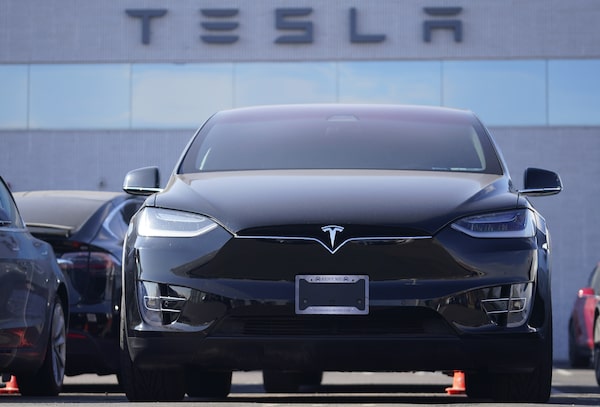
Stock splits make the shares more accessible to small investors and increase the liquidity of the company’s stock. That makes it easier to buy and sell the shares and narrows bid-ask spreads.David Zalubowski/The Associated Press
Sign up for the new Globe Advisor weekly newsletter for professional financial advisors on our newsletter sign-up page. Get exclusive investment industry news and insights, the week’s top headlines, and what you and your clients need to know.
A handful of big technology companies have split their shares this year after pandemic-induced bull runs of the past two years. The question for investors is how to view them. Are they a signal it’s time to jump into these stocks or a development that should be ignored?
Tesla Inc. TSLA-Q has become the latest to join in with shareholders approving a plan for a 3-for-1 split that goes into effect Aug. 25. This is Tesla’s second split in two years, after having had a 5-for-1 stock split in August 2020.
Tesla’s move follows Alphabet Inc. GOOGL-Q, Google’s parent company, which split both classes of its shares by a 20-for-1 ratio in July. In June, Amazon.com Inc. AMZN-Q did a 20-for-1 split and Shopify Inc. SHOP-T split 10-for-1.
“Splits make shares more affordable and accessible, but in the grand scheme of things, they don’t change anything,” says Hans Albrecht, vice-president, portfolio manager and options strategist at Horizons ETFs Management (Canada) Inc. in Toronto. “They leave a positive perception that things have gone well for the company.”
He adds that as splits tend to occur after a long run-up in prices, they signal momentum and suggest that better things lie ahead.
Splits don’t give shareholders any more value because such things as earnings and sales per share, as well as dividends, are also split in the same proportion. The splits do make the shares more accessible to small investors and increase the liquidity of the company’s stock. That makes it easier to buy and sell the shares and narrows bid-ask spreads.
As David Berman noted in a recent primer, splits fell out of fashion 20 years ago. From an average of 58 stock splits a year in the 1990s among companies in the S&P 500, the numbers fell to 8 splits a year in the 2010s.
Bank of America research analysts have concluded stock splits are traditionally bullish for the companies that enact them. They looked at data on S&P 500 stocks going back to 1980 and found that companies that split outperformed the index in the three, six and 12 months after the initial announcement. They gained on average 25 per cent over the next 12 months compared with a gain of 9 per cent for the benchmark index.
That trend hasn’t helped the companies that split this year. Their shares prices are down year-to-date and well off the prices when the splits were announced.
Split-adjusted, Shopify has fallen more than 80 per cent to around $43 a share from its 52-week high of approximately $223 as business conditions have deteriorated. Shopify laid off 10 per cent of its workforce and warned that inflation and rising interest rates will weigh on consumer spending for the remainder of 2022.
Amazon’s shares are 29 per cent below their 52-week high, post-split, at the current price of US$133.22. Alphabet is down 25 per cent at current prices.
The advantages of stock splits
Elliot Johnson, chief investment officer at Toronto-based Evolve Funds Group Inc., says the broader participation created by the splits has benefits.
Evolve launched Evolve FANGMA Index ETF TECH-T in May 2021 at a time when it cost more than $7,000 to buy one share of each of the six companies in the index. (The ETF includes Meta Platforms Inc. META-Q, Facebook’s parent company, Amazon, Netflix Inc. NFLX-Q, Alphabet, Microsoft Corp. MSFT-Q and Apple Inc. AAPL-Q.) So, to buy a board lot of 100 shares of each was over $700,000.
“That’s not user-friendly for the investing public and keeps advisors from allocating equities with large share prices to smaller accounts,” Mr. Johnson says.
Another advantage of lower share prices is that they allow for easier options trading. One call option represents 100 shares, so as an example, before Amazon’s 20-to-1 split, it was trading at US$2,800 a share. Institutions and portfolio managers wanting to use a covered-call strategy needed a minimum of US$280,000.
“This makes higher priced shares unsuitable for all sorts of applications, even institutional strategies. There’s no upside for the company to make their shares less accessible, so share splits are more helpful than not,” Mr. Johnson says.
Ultimately, stock splits may be one more reason to buy a company’s shares, but not the main one, Mr. Albrecht says. More important is how its business is performing and its prospects.
“It should never be the primary reason,” he adds.
Adam Mayers is a contributing editor to the Internet Wealth Builder investment newsletter.
For more from Globe Advisor, visit our homepage.